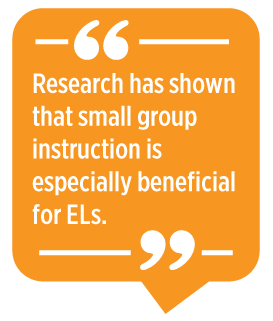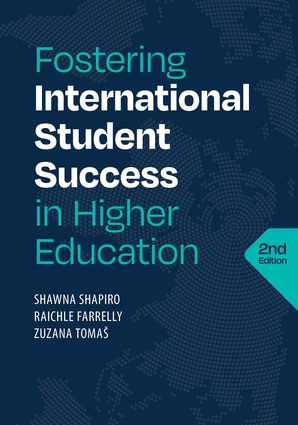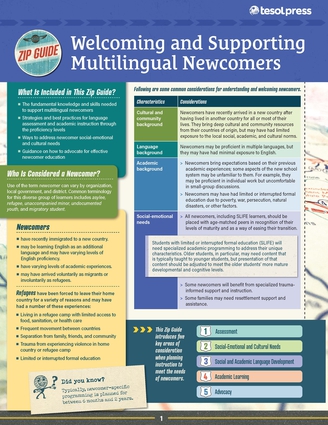Ask a TESOL Leader: "How can my content teachers teach content to all students and English language development to ELs in the same class?"
by Stacy Brown
Question: "I'm an administrator in a school where our content area teachers are required to teach content to all their students and, at the same time, English language development (ELD) to a small group of English learners (1–3 students) in the same class. The teachers have to adhere to our mandated curriculum for all students while also providing a block of ELD to the English learners, and we are all unsure of how to make this work. Any advice?"
In my experience, although it might take some time
to adjust routines to make this work smoothly, classroom teachers and both
English learner (EL) and non-EL students might benefit from the changes, since
all students are acquiring new academic language and content.
It might help if the staff has SIOP (Sheltered
Instruction Observation Protocol) training and gains additional awareness of
how to modify and differentiate instruction, if they haven’t already. Here is
some background on the
SIOP Model. There are many free related resources online. Here is a resource
I have found to be helpful. Jane Echevarria also provides background and
examples of ways to implement the model in the classroom here.
 Once teachers become aware of the needs of their
students, if they’re not already using small group rotations in their
classrooms, I would recommend giving them a try. Even 20–30 minutes per day for reading
rotations, for example, can make a huge difference over time in
language acquisition and reading proficiency for all learners. Many teachers
find that grouping by level and targeting skills during
small group time reaches more learners than whole group, and that it
allows them to differentiate instruction for all learners, including those who
are performing on and above grade level.
Once teachers become aware of the needs of their
students, if they’re not already using small group rotations in their
classrooms, I would recommend giving them a try. Even 20–30 minutes per day for reading
rotations, for example, can make a huge difference over time in
language acquisition and reading proficiency for all learners. Many teachers
find that grouping by level and targeting skills during
small group time reaches more learners than whole group, and that it
allows them to differentiate instruction for all learners, including those who
are performing on and above grade level.
Research
has shown that small group instruction is especially beneficial for ELs,
whether they are elementary or secondary students, and regardless of the
content. Working with small groups helps provide educators with data they might
not be able to acquire while doing whole group instruction so they can better
monitor growth. It also allows them to discover commonalities among students
and more opportunities throughout the day to tie language and content together.
Whether students are ELs, non-ELs, impacted by trauma, or excelling in all
areas, small group instruction usually helps them to better process new
information. Colleague Lara Shantz shares about some of these benefits
when her school adjusted their program.
For adjusting to small group rotations, one thing I
would suggest is to determine a selection of activity types that can remain
static. That way, the only new input the students experience is the content,
and the rest can become routine. Then from time to time, a new activity type
can be introduced. When doing that, it can be less time-consuming for teachers
to prepare and it can also empower a centers environment where groups can
function on their own. Before implementing the small groups, it can be helpful
to give a lesson on how the small group process will work. Small groups can be
a great opportunity to give more agency to students. They can be given roles
and responsibilities. Small groups are also proven to increase student
engagement. Here are some tips
for success.
I spent
several weeks recently with teachers in California, where similar models (in
which classroom teachers instruct their ELs within their classrooms, along with
all content) are used throughout the state; you might reach out to colleagues
at CATESOL.
We can also survey members in the TESOL PreK-12 Interest Section in the myTESOL
community to try to find others who might be using a similar
approach. If you’re a TESOL member, feel free to join us there!
Do you have a question for the TESOL leadership? Email your question to tc@tesol.org with the subject line "Ask a TESOL Leader" and it could be featured in this column!
Stacy Brown is a trauma and policy specialist, multilingual English language development educator, and international emergency case worker. She serves trauma survivors in the United States and 58 countries across the globe, assisting with issues related to displacement, war and severe conflict, education, healthcare, mental health, labor and human rights, and legal crises.
TESOL Blogs
Interested in writing a blog for TESOL?
Read the submission guidelines and send us your post!
Check out some of the most recent TESOL Blogs:
|
Creating Engaging Classroom Podcasts With Canva: A Step-by-Step Guide, by Brent Warner

Using Canva to record and edit podcasts is the easiest way to get students talking, and it's a fun way to engage students in pretty much any language learning class. Here are the stages to create simple spoken projects to practice pronunciation or full-length audio productions to refine fluency. |
|
Professional Development During Times of Crisis, by Laura Baecher

Guest Bloggers: Ukranian Educators Svitlana Smolina, Nataliya Prokopchuk, Tetiana Konovalenko, Olha Bilyk, and Nadiia Grytsyk
Ukrainian TESOL faculty and professional development leaders, who are currently living in extreme conditions of crisis, share strategies for continuing to learn and grow professionally during such times. |
TESOL Bookstore

Featured Resources from TESOL Press
ELT Basics is an invaluable resource for those seeking a straightforward, practical, and foundational understanding of English language teaching. This book covers a broad range of important topics, such as what it means to “know” a language, how people learn new languages, and what teachers can do to teach English effectively. Whether you’re looking for a basic understanding of ELT or considering a career in language teaching but want to know more first, this book will teach you about language acquisition as well as how to plan, instruct, and assess multilingual learners of English.
 Fostering International Student Success in Higher Education, Second Edition
Fostering International Student Success in Higher Education, Second Edition
Shawna Shapiro, Raichle Farrelly, Zuzana Tomaš
(Copublished by TESOL and NAFSA)
The increase in the number of international students attending English-dominant schools brings benefits as well as challenges for institutions. Shapiro, Farrelly, and Tomaš provide a lively, informative discussion that answers the questions instructors commonly ask when seeking to ensure success for these students: What do I do to help students be successful in U.S. academic culture? How can I ensure that the content for my course is comprehensible to students who are still learning English? How do I design assignments and assessments that are fair while still acknowledging the difficulty of doing academic work in a second or foreign language? How might I treat international students as a linguistic and cultural asset in the classroom, and help them to become institutionally integrated?
 TESOL Zip Guide:
TESOL Zip Guide:
Welcoming and Supporting Multilingual Newcomers
Amber Warren, Melissa Hauke, Jan By Ying Hui-Michael, Adrienne Johnson
Newcomers are students who have recently immigrated to a new country, may be learning English as an additional language, and may have varying levels of English proficiency. This guide introduces five key areas of consideration when planning instruction to meet the unique social-emotional, linguistic, cultural, academic, and programming needs of multilingual learners of English who are newcomers. It includes strategies and best practices for language assessment and academic instruction through the proficiency levels, and guidance on how to advocate for effective newcomer education.